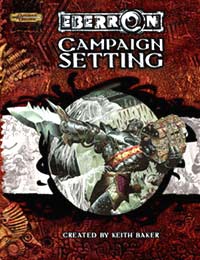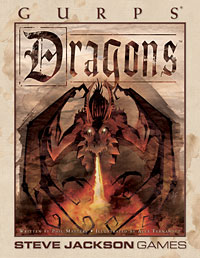By Jonathan Woodward
Nov 15, 2004
This month, I thought I'd offer some reviews. This should come as a shock to no one.
"Can I Play a Half-Shapeshifter, Half-Construct? No?"
The great big new campaign setting for D&D is here. Eberron (Wizards of the Coast, 320 pages, hardcover, color, $39.95) is a huge tome of a book, suitable for whacking people over the head. It's got everything you've come to expect in such books, including new races, a new base class, new feats, new prestige classes, new spells, new gear, new magic gear, new monsters, and a shiny new world.
 |
| Eberron Campaign Setting |
My very first oh-cool moment with this book was in looking over the new PC races. One is optimized to work well with psionics, and that didn't interest me much. One is sort of a lycanthrope lite, which is mildly cool, but still not my mugga. The other two, however, are a simplified doppelganger race, and a simplified construct race. These got my attention. Since Savage Species came out, I've been looking at monster races with an eye to seeing which ones are suitable as PCs. Most constructs (even the nummy Kolyarut from Manual of the Planes) are too robotic, or too pricy. Dopps are pretty expensive, too. But here they are, the Warforged and the Changeling, playable starting races. It is to gasm.
Further nifty stuff: One of the conceits of the setting is that magic and magic items are overall better understood and utilized. The new spells include several designed to better integrate magic into a world's economy. The most notable is Magecraft, which enhances a crafter's work. The assumption is that many people perform their jobs under the influece of this spell, thus producing more and better mundane and magical goods. Similarly, it is possible to buy steeds who have been raised under the influence of magic (magebred), and thus are smarter, stronger, and faster. The new base class, the Artificer, is a magic items technican, and can use almost any item, change its abilities, drain it for power, or use spell-like infusions to enhance them. (Though I found the text a little vague on what, exactly, an infusion is. How would a character describe it? Some kind of potion?)
Sometimes these magical improvements are a little too cute, what with the magical telegraph and magical railroads. However, these are apparently included to bolster the 1930s-pulp feel of the setting. They frequently point out that their intent is to provide a setting for "swashbuckling adventure" and "urban mystery", but you have to be paying attention to realize that they mean, "This is the 1930s, as if they were fantasy, and you can run pulp and noir here." It's an interesting twist, and I hope it works for them. People may end up just playing classic hack-n-slash D&D, regardless of the designer's intent. Pulp and noir have always been tricky for the RPG industry to get right.
Constructs, as the warforged race, are also well integrated. Entirely apart from being an intelligent PC race, they have religions and a place in the social order, a slew of new spells devoted to enhancing or damaging them, a handful of construct-specific feats, and a prestige class that turns them into juggernauts. However, the book is careful not to suggest that warforged must be fighters, and there are pictures of warforged in other roles, such as a wizard.
In regards to game balance, the book is almost too tightly balanced. For example, the warforged are cool, but they have a lot of drawbacks, too. (Like, they're harder to heal.) Many of the prestige classes also have downsides to consider, and the feat progressions are carefully restricted by prereqs. Overall, there was no place where I said, "Ooo, I gotta take this." There were always pros and cons. And, while I'm mentioning feats, the book needed a few more character creation hints in that chapter. For example, if you ever want to take the Warforged Juggernaut prestige class, you must take Adamantine Body as a first-level feat, during character creation. Anyone who doesn't analyze things too closely might end up disappointed.
In the Wizards' tiresomely predictable fashion, they've made the book gorgeous. Editing is great, layout is readable and clear, the art is beautiful and evocative (though Kev Walker clearly wants to be Mike Mignola in the worst way; see p. 10). The maps, on the other hand, have issues. The world map that appears three times (both endpapers and in the middle) has the outlines of the continents, the names of the continents, the names of the oceans, and dreck-all besides. The map of the main continent (Khorvaire, on p. 135) has the geography marked, the names of the regions, the names of two bodies of water, and that's it. It even lacks politcal boundaries, which would have helped immensely. Each region then gets its own closeup map, where they give you the detail in the region, and nothing beyond it, so you have to flip back and forth to find out where that road leads, or who lives beyond those mountains. "Is that forest part of Breland, or Thrane? [flip, flip]" Still, the stuff they did put on the maps is pretty and legible. They just need to make it easier for people to understand the world holistically.
Plus, much looser alignment restrictions (good red dragons, evil paladins), the aberration monster type as cross-dimensional Lovecraftian invaders, action points (about which I am ambivalent), and dragonmarks (magical birthmarks). And a detective prestige class, living spells, carcass crabs, and a heckuva lot more. In summation, whle Eberron isn't groundbreaking in the way, say, Planescape was, it's still a very solid fantasy world with many interesting quirks. It also has lots of material that can be used in other settings with minimal effort. If $40 isn't going to kill you, I strongly recommend it as a source of new crunch. If you really want a new world to game in, with integrated magic serving as kinda-technology, very definitely recommended. But, if $40 is a little over your optimum price point, flip through it first.
But You Can Play a Half-Dragon . . .
GURPS Dragons (Steve Jackson Games, 160 pages, hardcover, color, $29.95) is quite likely the last book for GURPS Third Edition, what with Fourth Edition rocketing onto the shelves as I type this. In the interests of full disclosure, it's written by my occasional co-author, Phil Masters. So I'm probably going to be less snarky than I might if it had been written by some random schmuck.
This book is very distinctly different from the D&D Draconomicon, which I reviewed a few months back. That book was about the D&D dragon and related beasts; a distinctly modern, post-Tolkien sort of critter, well-defined within the framework of D&D canon. GURPS Dragons, on the other hand, is about building your own dragon mythos, working from the ground up. Chapter one starts out with the mythology of dragons, breaking the topic down by time and geography. It draws some very nice distinctions between western and eastern dragons, and presents the key characteristics of the types. Follow these rules, and what you end up with is true to dragon myth, guaranteed. The chapter also doesn't stint on modern dragon myth, devoting time to Smaug, Godzilla, and the somewhat annoying shoulder dragons.
Chapter two is about fitting dragons into a roleplaying game, or (in some cases) fitting a game around dragons. Their potential roles as antagonists and protagonists are covered, as are certain logical
 |
| GURPS Dragons |
The next three chapters are rules-oriented, designed for building dragons either quickly or step-by-step. Chapter three presents over a dozen dragon racial templates, plus variations by age. Because dragons are powerful beasts, the templates are a little unwieldy, but that's pretty much inevitable. The next chapter breaks out individual dragon traits, and shows how to handle them in rules terms. (I.e., what if its breath weapon is corrosive? How big does it have to be to tackle a tank? How do I do a claw/claw/bite attack?) Lastly, chapter five is all about dragon magic. The best part of this chapter are the lenses (add-on templates) providing ready-to-go spell lists for dragons of different types, such as the Storm Lord or the Subtle Wyrm.
Humans, being much less interesting, get only one chapter, much of which amounts to "Dragons think you're good with ketchup, so be careful." The section on 101 Things To Do With a Dead Dragon strikes me as a tad optimistic, while the bit about how spiked armor makes you harder to swallow is more realistic. Plus, of course, a selection of PC templates, such as the Thoughful Dragon-Slayer and the Servile Minion.
Chapters seven through nine present a campaign setting, titled The Dragons Return. The premise is that, in 1878, a whole lot of dragons appeared on Earth. No one is quite sure from where -- not even the dragons themselves. They are smart enough to not cause too big a fuss, and tend to be quiet manipulators. If a dragon gets into a big ruckus with a bunch of armed humans, it's made a huge mistake. Dragons also know magic, and have taught some to humans. Otherwise, the world looks a lot like the real Earth, since the dragons operate in secret. Indeed, a lot of people think they're a hoax.
The setting has a lot of British, post-steampunk, pre-pulp charm (much like its author, actually), and is suitable for globe-spanning conspiratorial plots, but strikes me as just a bit too sedate. Big battles with flame-spewing, pissed-off reptiles are explicitly rare. (Or, at best, very lethal to PCs -- only six dragons have ever been killed by humans.) Having a dragon as a criminal mastermind is a little more interesting than just another power-mad human, but it's not a lot more interesting. It definitely didn't push my "I have got to run this," button.
The final chapter is a bunch of micro-settings, covering all genres from Godzilla-stomps to apocalyptic fantasy to surreal dragons-in-the-mirrors horror. The delightful "Wisdom of Pearls" Bronze Age China setting would probably have been my choice for the main setting for the book. Lastly, the book contains a conversion guide for using it with Fourth Edition.
The production values are good; if this is a preview of the Fourth Edition look, it'll be nice. Editing is nearly perfect, though I noticed a half-dozen or so typos, total. The art is by Alex Fernandez, which means that we get some very nice, angular pictures of dragons. And that's about it. Nearly every piece is just a dragon; no backgrounds, few people, few props, pretty much just dragons. So, repetitive, but very pretty. Overall, the book is strongly recommended to fantasy GMs running GURPS, and still moderately recommended to fantasy GMs running other systems.
Useful Links:
Want me to review your game? I'm delighted to accept review copies care of Blue Blood.
